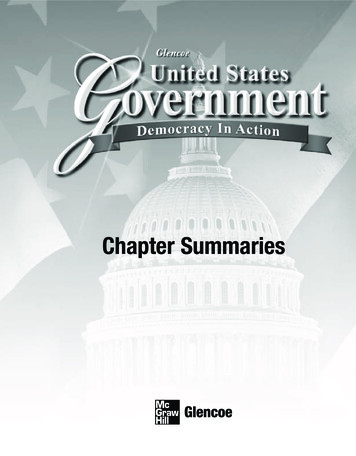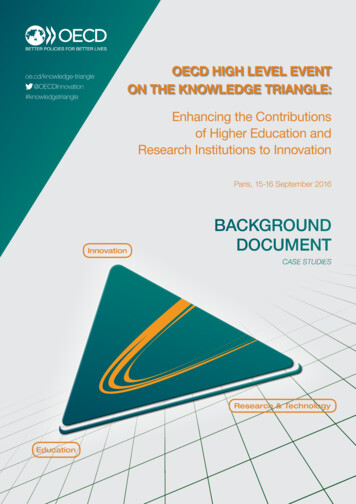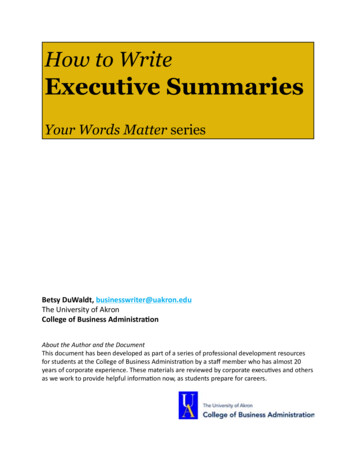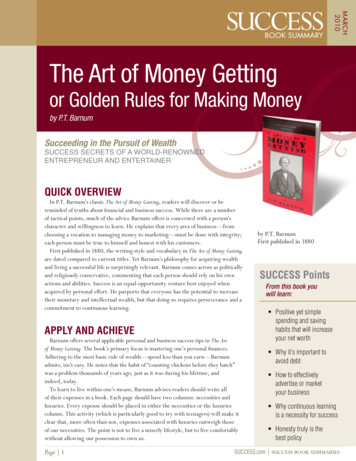
Transcription
Chapter Summaries
To the TeacherThe United States Government: Democracy In Action Chapter Summaries booklet providesteachers with flexibility in planning the study of government. Each summary condenses theinformation in the relevant chapter so that teachers may use abbreviated versions of some chapterswhen lack of time makes that necessary. Each summary is accompanied by a student activity page.Copyright by The McGraw-Hill Companies, Inc. All rights reserved. Permission isgranted to reproduce the material contained herein on the condition that such materialsbe reproduced only for classroom use; be provided to students, teachers, and familieswithout charge; and be used solely in conjunction with the United States Government:Democracy In Action program. Any other reproduction, for sale or other use, isexpressly prohibited.Send all inquiries to:Glencoe/McGraw-Hill8787 Orion PlaceColumbus, OH 43240-4027ISBN: 978-0-07-891364-8MHID: 0-07-891364-0Printed in the United States of America.1 2 3 4 5 6 7 8 9 10 079 14 13 12 11 10 09
Table of ContentsTo the Teacher . iiChapter Summaries UNIT 1Foundations of American GovernmentActivityActivityActivityActivityPeople and Government . 1The Origins of American Government . 4The Constitution . 7The Federal System . 101234 UNIT 2The Legislative BranchActivity 5Activity 6Activity 7The Organization of Congress . 13Development of Congressional Powers . 16Congress at Work . 19 UNIT 3The Executive BranchActivity 8Activity 9Activity 10The Presidency . 22Presidential Leadership . 25The Federal Bureaucracy . 28 UNIT 4The Judicial BranchActivity 11Activity 12The Federal Court System . 31Supreme Court Decision Making . 34 UNIT 5Liberty and Justice for AllActivity 13Activity 14Activity 15Constitutional Freedoms . 37Citizenship and Equal Justice . 40Law in America . 43 UNIT 6Participating in l Parties .Elections and Voting .Interest Groups and Public Opinion .Mass Media and the Internet .1617181946495255 UNIT 7Public Policies and ServicesActivity 20Activity 21Activity 22Taxing and Spending . 58Social and Domestic Policy . 61Foreign Policy and Defense . 64 UNIT 8State and Local GovernmentActivity 23Activity 24State Governments . 67Local Governments . 70 UNIT 9Political and Economic SystemsActivity 25Activity 26Political Systems in Today’s World . 73Development of Economic Systems . 76Answer Key . 79Chapter Summariesiii
Customize Your ResourcesNo matter how you organize your teaching resources, Glencoe has what you need.The Teacher’s Classroom Resources for United States Government: Democracy In Actionprovides you with a wide variety of supplemental materials to enhance the classroom experience.These resources appear as individual booklets in a carryall tote box. The booklets are designedto open flat so that pages can be easily photocopied without removing them from their booklet.However, if you choose to create separate files, the pages are perforated for easy removal. You maycustomize these materials using our file folders or tabbed dividers.The individual booklets and the file management kit supplied in Teacher’s Classroom Resourcesgive you the flexibility to organize these resources in a combination that best suits your teachingstyle. Below are several alternatives: Organize all resources by category(all tests, all enrichment and extension activities,all cooperative learning activities, etc., filed separately) Organize all resources by category and chapter(all Chapter 1 activities, all Chapter 1 tests, etc.) Organize resources sequentially by lesson(activities, quizzes, readings, etc., for Chapter 1, Chapter 2, and so on)ivChapter Summaries
NameDateClass1People and Government PRINCIPLES OF GOVERNMENT To students of government, the terms state andcountry have the same meaning. A state is a politicalcommunity with definite boundaries and an independent government.We call the main political divisions within ourcountry states, because when the colonies declaredtheir independence, they thought of themselves as13 separate countries. They later joined as onecountry but still referred to themselves as “states.”Technically, the word nation refers to a group ofpeople united by culture. However, we will use theterms nation, state, and country interchangeably.FOUR ESSENTIAL FEATURES OF STATESPopulationall the people who live in the state. The state is more likely to be stable if thepopulation agrees about basic beliefs, or has social consensus.Territorythe area within established boundaries. Territory can be a source of conflictamong states and may change through war, negotiation, or purchase.Sovereigntyauthority to conduct internal affairs without seeking approval from a higherauthority or other nations.Governmentthe institution through which a state maintains social order, provides publicservices, and enforces the nation’s laws.Copyright by The McGraw-Hill Companies, Inc.Government serves several major purposes for the state: It maintains social order by making laws andpunishing individuals who break those laws. It provides essential public services thatpromote the general welfare of the people. It handles relations with other nations andprotects citizens from attack. It makes decisions that influence the nation’seconomy. THE FORMATION OF GOVERNMENTS Most large countries have several levels of government. In a unitary system, a central or nationalgovernment has supreme power. It has the power tocreate lower levels to govern smaller units and maygive those agencies limited authority. In a federalsystem, the central and regional governmentsshare powers. The United States Constitution created a federal system.A constitution is a plan of government. Writtenconstitutions express national ideals in a preamblestating the goals and purposes of the government.The main body of the document describes the basicstructure of the government and defines its powersand duties. To be constitutional, a government mustaccept that its powers are clearly limited by theconstitution.Politics, the effort to control or influence government conduct and policies, provides a peaceful wayfor society to manage conflict and competition.(continued)Chapter Summaries1
NameDateClassChapter 1 Summary continued TYPES OF GOVERNMENT Aristotle, an ancient Greek philosopher, identified three types of governments: autocracy, or rule by one person oligarchy, or rule by a few people democracy, or rule by many peopleThe key idea of democracy is that the people havesovereign power. In a direct democracy, people voteon every issue. Many nations rely on indirect, orrepresentative democracy, in which the people electrepresentatives to whom they delegate the power togovern. The United States is a republic, a representative democracy in which the people, who hold sovereign power, elect lawmakers and a head of state.Democracy seems to flourish in countries withoutextremes of wealth and poverty and with a largemiddle class. The opportunity to control one’s owneconomic destiny provides a basis for makingindependent political decisions. In the UnitedStates, this concept is called free enterprise. Stable, ECONOMIC THEORIES It promotes individual liberty, or equalopportunity for all people. It is based on majority rule with minority rights. It requires elections in which candidates canexpress their views freely, voting requirementsare few and nondiscriminatory, and each person’s vote is equal and cast by secret ballot. It allows competing political parties, with different approaches to issues, to give voters a choice.private ownership of property and resourcesfree enterprisebusiness competitionfreedom of choicethe possibility of profitsBuyers and sellers have unlimited freedom tomake economic decisions in a free market. The government adopts a laissez-faire (“to let alone”) policy.No nation has a pure capitalist system. The UnitedStates is a mixed-market economy, one in whichfree enterprise, or capitalist practices, are combinedwith and supported by government influences.Under socialism, the government owns the meansof production and makes economic decisions.Socialism has three goals: public ownership of the basic means ofproduction government control over key economicpolicies equal distribution of wealthSocialists believe that workers should share equallyin the benefits of production. Opponents say thatsocialism stifles individual initiative and hinderseconomic growth through high taxes.Communism holds that history is a strugglebetween two classes. The bourgeoisie own the meansof production and use their economic power tooppress the proletariat, or workers. This struggle mustend in violent revolution, after which governmentowns the means of production and distribution. Intime one class will evolve, property will be held incommon, and there will be no need for government.In Communist systems, as they exist today, all decisions are made at the upper levels of government.Chapter SummariesCopyright by The McGraw-Hill Companies, Inc.Capitalism has five characteristics:2Democracy has four characteristics: Economics is the study of human efforts to satisfyseemingly unlimited wants with limited resources.The world’s three major economic systems arecapitalism, socialism, and communism. growing economies support democracy. Dictatorsmay topple democratic governments during aneconomic depression. Democracy and educationseem to be interrelated. An educated public makeswiser political decisions. Democracy needs a civilsociety, a network of voluntary associations to helppeople express their views. Democracy prosperswhere the social consensus is that individual libertyis valuable.
NameDateClass1People and Government DIRECTIONS In the blank to the left of each term, write the letter of the statement that most closelymatches it from the box below.1. sovereignty5. laissez-faire policy2. federal system6. representative democracy3. constitution7. social consensus4. politics8. mixed-market economyA. In this political system, people delegate toelected officials the power to govern.E. In this political system the national governmentand regional governments share powers.B. This term describes a written or unwrittenplan of government.F. This term refers to the general agreementamong most people about values.C. This economic system combines freeenterprise with government regulation.G. This term refers to a state’s authority toconduct internal affairs without seekingapproval from other nations.Copyright by The McGraw-Hill Companies, Inc.D. This term describes the effort to control orinfluence government conduct and policies.H. The government does nothing to interferewith the economy.Organizing Information Examine the following diagram and study the list of characteristicsassociated with capitalism and socialism. Write each phrase in the appropriate space in the diagram.CAPITALISMSOCIALISMHow DifferentPropertyResourcesEconomic DecisionsMonetary Rewards public ownership of property equal distribution of wealth private ownership of resources government control of key economic decisions freedom of choice private ownership of property public ownership of resources possibility of profitsChapter Summaries3
NameDateClass2The Origins of American Government THE COLONIAL PERIOD English colonists who settled in America inthe 1600s brought along two important politicalconcepts: limited government and representativegovernment. The Magna Carta and the EnglishBill of Rights had established limited government.British colonists believed that their monarch ruledby their consent. They could not be deprived oflife, liberty, or property, except according to law.Each colony in North America set up a representative government, elected by the people. UNITING FOR INDEPENDENCEHowever, only white men who owned propertycould vote. Though flawed, these governmentsset precedents: a written constitution that guarantees basicrights and limits government powers, an elected legislature, the separation of powers between the executive(governor) and the legislature. As hostilities escalated, an independence movementtook root, and on July 4, 1776, the delegates approvedthe Declaration of Independence drafted by ThomasJefferson. The Declaration has three parts: The preamble includes a statement of purposeand a description of basic human rights. The main body lists 27 grievances—specificways in which the colonists believed that theking had violated their political liberties. The conclusion states the colonists’ determination to separate from Great Britain.Delegates to the Continental Congress signed theDeclaration of Independence as representatives ofindividual states. Each state drafted its own constitution recognizing the people as the source of government and limiting government powers. Most ofthe new constitutions contained bills of rights. THE ARTICLES OF CONFEDERATION In 1781 the states set up a league of friendship,under the Articles of Confederation, which gave eachstate one vote in a congress that made laws and settled disputes. The Articles, however, had major flaws: Congress could not levy taxes or regulate trade. Congress could not compel a state to obey itsdecisions; there was no executive to enforceits laws.(continued)4Chapter SummariesCopyright by The McGraw-Hill Companies, Inc.Cordial relations between Great Britain and thecolonies changed after 1763. War had ended theFrench threat to the colonies but had left Britaindeeply in debt. The king expected the colonists tohelp repay that debt. Angry colonists protestedParliament’s new taxes by boycotting British goods.In 1773 colonists dumped a shipload of tea intoBoston harbor in protest. Parliament then passedlaws to punish Boston. Furious colonists calledthese laws the Intolerable Acts.The Intolerable Acts united the colonists againstBritish authority. In 1765, nine colonies met in NewYork at the Stamp Act Congress—the first formalmeeting to protest King George III’s actions. A newsense of community prompted 12 colonies to senddelegates to the First Continental Congress in 1774.Those delegates agreed to prohibit trade with GreatBritain and to meet again in May 1775. By the timethe Second Continental Congress met, the first battles of the Revolutionary War had been fought.
NameDateClassChapter 2 Summary continuedTHE ARTICLES OF CONFEDERATION (continued) Amending, or changing the Articles, required theconsent of every state, and unanimous agreementon any issue did not exist.Weaknesses of the Articles led to severe problems.States quarreled over boundaries and interstatecommerce. The central government could not payits debts. An economic depression led to a farmers’revolt. The resulting unrest frightened Americanleaders, so Congress authorized a convention ofthe states in 1787 for the purpose of “revising theArticles of Confederation.” THE CONSTITUTIONAL CONVENTION Delegates from 12 states attended theConstitutional Convention. All favored limitedand representative government, separation ofpowers among legislative, executive, and judicialbranches, and a stronger national government.Their mandate was to revise the Articles, but thedelegates soon abandoned that charter to write anew constitution. They first considered the VirginiaPlan, which had three components:Copyright by The McGraw-Hill Companies, Inc. a two-chamber legislature with the power todeclare state laws unconstitutional a strong executive chosen by the legislature a national judiciary chosen by the legislatureDebates over slavery and commerce led to morecompromise. Southern states wanted enslavedpersons to count for representation, but not fortaxation. Northern states took the opposite position.Under the Three-Fifths Compromise, three-fifths ofenslaved people would be counted for both taxationand representation. To satisfy the sectional interestsof the North and the South, the delegates agreedthat Congress could not ban the slave trade until1808. They gave Congress the power to regulateforeign and interstate commerce, or trade amongthe states, but forbade it to tax exports.This plan, in modified form, eventually becamethe basis for the Constitution. The small states,fearing domination by the large states, introducedthe New Jersey Plan. It retained the one-chamber,one-vote-per-state legislature but gave it the powerto tax and regulate trade. The plan also created aweak executive and national courts with limitedpowers. The delegates rejected those ideas andreturned to considering Virginia’s plan.In September 1787 the delegates sent theConstitution to the states for ratification. Forthe new Constitution to take effect, nine of thethirteen states had to approve it. The debatedivided the public. Supporters of the Constitution,or Federalists, argued that only a strong nationalgovernment could protect the nation from enemiesand solve its internal problems. Opponents, or AntiFederalists, feared a strong central government. Theywarned that without the protections of a Bill ofRights, the government could take away libertieswon in the Revolution.The Convention deadlocked over representation.Large states favored representation based onpopulation, while the small states wanted equalrepresentation regardless of population. TheConnecticut Compromise broke the stalemate.It called for a Senate with two members from eachstate and a House of Representatives, with representation based on population. All revenue laws—those concerning spending and taxing—wouldoriginate in the House.The Federalists promised that the new government would immediately add a Bill of Rights to theConstitution. This promise turned the tide in theirfavor. On June 21, 1788, New Hampshire becamethe ninth state to ratify, and the Constitution wentinto effect. By 1790 the new Constitution had theunanimous approval of the thirteen United Statesof America. It would continue to be the law of theland as the United States spread across the NorthAmerican continent.Chapter Summaries5
NameDateClass2Origins of American Government DIRECTIONS Answer the following questions in the space provided.1. What two especially important English political concepts greatly influenced the development of theUnited States?2. What was the unintentional effect of the harsh tax laws passed by Parliament between 1763 and 1773?3. What proposal, in modified form, became the basis for the Constitution?4. What proposal broke the stalemate over representation by suggesting a Congress composed of a Houseof Representatives and a Senate?5. What agreement determined the guidelines by which enslaved persons would be counted for purposesof taxation and representation?Organizing Information Examine the following time line. Study the list of historical events belowand review Chapter 2 to find the correct dates for each. Place each event in the appropriate space provided onthe time line.1775178017851790 Declaration of Independence signed New Hampshire ratifies the Constitution First Continental Congress convenes Constitutional Convention meets Articles of Confederation take effect All 13 states have ratified the Constitution Second Continental Congress convenes Boston Tea PartyCritical Thinking Answer the following questions on a separate sheet of paper.6. Why do you think the founders stipulated that all laws concerning spending and taxation mustoriginate in the House of Representatives?7. Explain why you think the delegates to the Constitutional Convention were right or wrong incompromising on the slavery issue?6Chapter SummariesCopyright by The McGraw-Hill Companies, Inc.1770
NameDateClass3The Constitution STRUCTURE AND PRINCIPLES The United States Constitution has three parts:the Preamble (which lists the goals of Americangovernment), the articles, and the amendments.The body of the Constitution contains sevendivisions called articles.Article I creates Congress, the legislative branchof the national government, and describes its twochambers—the House of Representatives and theSenate. Article I also spells out procedures for makinglaws and lists the types of laws Congress may pass.Article II creates an executive branch, thepresidency, to carry out the laws Congress passes.It describes the powers and duties of the presidentand qualifications for the office.Article III establishes a Supreme Court to headthe judicial branch and gives Congress the powerto create lower federal courts.Article IV explains the relationship of the statesto one another and to the national government.This article requires that each state give citizens ofother states the same rights as its own citizens andsets up procedures for admitting new states.Article V provides rules for amending, or changing, the Constitution.Article VI contains the supremacy clause. Thisclause establishes the Constitution as the “supremelaw of the land.”Article VII states that the Constitution wouldtake effect after it was ratified by nine of thethirteen states.The third part of the Constitution containsthe 27 amendments, or changes, that have beenadded to date.Copyright by The McGraw-Hill Companies, Inc.SIX MAJOR PRINCIPLES OF THE CONSTITUTIONpopular sovereigntyThe government is based upon the consent of the governed and derives itsauthority from the people.federalismThe states share power with the national government.separation of powersDividing responsibilities among the three branches prevents any one branchfrom acquiring too much power.checks and balancesEach branch of government is permitted to exercise some control over the others.judicial reviewThe courts have power to declare laws invalid if they violate the Constitution.limited governmentThe Constitution restricts the actions of government by specifically describingits powers and listing powers the government does not have. THE THREE BRANCHES OF GOVERNMENTThe Founders expressed, or enumerated, thepowers given to Congress. Five of these enumeratedpowers cover economic legislation, such as the powerto tax and to regulate commerce. Seven others arerelated to defense. Five more involve miscellaneousspecific powers. The eighteenth enumerated powergives Congress the right to make all laws “necessaryand proper” to carry out its other powers. This isChapter Summaries called the elastic clause because it allows Congress to“stretch” its powers in unforeseen situations.Article II begins by stating, “The Executive Powershall be vested in a President of the United Statesof America.” Some scholars call this the executive“wild card.” Presidents have used “executive power”to justify powers not specified in the Constitution.Article II describes some executive powers as follows:(continued)7
NameDateClassChapter 3 Summary continuedTHE THREE BRANCHES OF GOVERNMENT (continued)The president(1) is commander-in-chief of the armed forces;(2) with the Senate’s consent, appoints ambassadors, judges, and other officials;(3) makes treaties with the consent of the Senate;(4) calls Congress into special session, ifnecessary;(5) meets with foreign officials; AMENDING THE CONSTITUTION By providing for amendments the Founderscreated a Constitution that could be adapted tofuture needs. Amendments are proposed at thenational level in two ways: a two-thirds vote ofeach house of Congress or a national conventioncalled by Congress at the request of two-thirds of thestates. Amendments can also be approved in twoways: if legislatures in three-fourths of the statesratify the amendment or if each state calls a ratifying convention. Either way, Congress sets a timelimit, usually seven years, for the states to decide.The Constitution keeps pace with the timesthrough informal changes as well. Some changesoccur as Congress makes laws that enlarge or clarifyconstitutional provisions, for example, by passing The first ten amendments, the Bill of Rights,protect individual liberties and the rights of personsaccused of crimes.The First Amendment guarantees freedom ofreligion and protects freedom of speech and of thepress. The government cannot stop people fromexpressing unpopular opinions, nor can it imposeprior restraint, censorship of information before itis made public.The Second Amendment supports the right toown firearms, but does not ban government regulation of the use and sale of weapons.The Third Amendment prohibits the government from forcing people to provide shelter forsoldiers in their homes.The Fourth Amendment protects the right toprivacy. Police need a warrant and probable cause, areasonable basis for believing that a person or place8many complex tax laws. Other changes result fromthe ways in which the branches of government usetheir powers.Modern presidents often conduct foreign affairsby executive agreement, a pact between the presidentand another head of state. Unlike treaties, which arepacts between nations, executive agreements do notneed Senate approval.Federal courts bring about change through rulingsin legal cases. Advocates of judicial restraint believethat the courts should uphold laws unless they clearlyviolate a specific provision of the Constitution.Supporters of judicial activism believe the courtsshould interpret the Constitution in ways that bringabout social change.is linked to a crime, before a search or arrest.The Fifth Amendment guarantees that no onemay be deprived of life, liberty, or property withoutdue process—proper constitutional procedures inlegal action against individuals.The Sixth through Eighth Amendmentsprovide protections such as the right to a fairand speedy trial by jury and a ban on “cruel andunusual punishment.”The Ninth Amendment says that all basic rightsnot specifically mentioned in the Constitution are“retained by the people.”The Tenth Amendment notes that powers notgiven to the national government—or denied to thestates—by the Constitution belong to the states orto the people.Seventeen other amendments, covering variousissues, have been added over the years.Chapter SummariesCopyright by The McGraw-Hill Companies, Inc. THE AMENDMENTS(6) ensures that the laws of Congress arefaithfully executed.Article III calls for a Supreme Court and any lowercourts Congress may establish. The Constitutiongives federal courts jurisdiction, or authority, overcases involving United States laws, treaties, interpretations of the Constitution, and the law of the sea.State courts have jurisdiction in other kinds of cases.
NameDateClass3The Constitution DIRECTIO
Aug 16, 2012 · representatives to whom they delegate the power to govern. The United States is a republic, a representa-tive democracy in which the people, who hold sover-eign power, elect lawmakers and a head of state. Democracy seems to flourish in countries without extr











